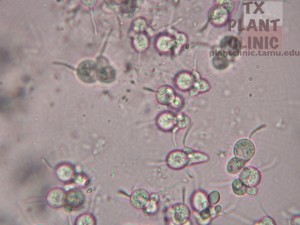Seen in 2011 at the Plant Clinic
Submission numbers for plant disease diagnosis are usually lower in the winter months. So it is always interesting to see what shows up, because sometimes it reflects what might be problematic when spring comes around. In the first week of operation in the new year, an interesting observation was the diagnosis of Entomosporium leaf spot from a specimen of Indian Hawthorn (Rhaphiolepis indica). This is a fungal disease that seems to flare up when there is sufficient moisture in cool conditions. Well, in many parts of Texas, we are experiencing a relatively mild winter. It was not surprising to find this fungus active on a susceptible cultivar of the plant. We can expect problems with this disease if mild and wet weather conditions continue into the spring. Not only will this fungus cause unsightly spots on plants such as the Indian Hawthorn and red-tip Photinia, a severe infection can result in premature defoliation. Some simple management measures that can be taken would include drip irrigation and mulching the base of the plant to reduce splashing of water, which can be a vehicle for spore dissemination. Removal and destroying defoliated leaves will help in reducing overall inoculum levels (amount of spores to cause new infection). In addition, there are several fungicides that can be used to protect new foliage. For more information on this disease, download the factsheet at http://agrilifelearn.tamu.edu (publication E-175) and/or contact your local AgriLife Extension county office for assistance.



